Abstract
Purpose
Everolimus (RAD001, Afinitor) is an mTORC1 pathway inhibitor, and vatalanib (PTK/ZK) is a pan VEGF-R tyrosine kinase inhibitor (TKI). These two drugs have been shown to have overlapping but also distinct anti-angiogenic effects. Consequently, we investigated the pharmacokinetics (PK) and pharmacodynamics (PD) of their combination in vivo.
Methods
Murine melanoma B16/BL6 cells were grown orthotopically in BL6/C57 mice by injection into the derma of both ears to create a primary tumour which metastasized rapidly to the cervical lymph nodes. Mice were treated daily p.o. with PTK/ZK (100 mg/kg) or everolimus (1 mg/kg) or their combination, and anti-tumour efficacy (PD) assessed. In the same model, plasma PK of everolimus was measured following single doses of the monotherapy or combination schedules.
Results
Two independent experiments showed that combination of everolimus and PTK/ZK caused at least additive increases in anti-tumour activity compared to either monotherapy, without increases in toxicity. Pooling the data to improve the statistical power demonstrated the interactions to be synergistic. PK modelling showed that although PTK/ZK increased everolimus plasma concentrations by about twofold, this PK drug–drug interaction could not account for the increased anti-tumour effect of the combination. Modelling of the PTK/ZK dose–response curve in this model suggested that any effect of everolimus on the PK of PTK/ZK was unlikely to affect efficacy. Measurement of changes in tumour and plasma VEGF levels at the endpoint of therapy confirmed earlier observations of differential effects of these two agents.
Conclusions
The combination of everolimus and PTK/ZK hold promise for the treatment of human cancers.





Similar content being viewed by others
Abbreviations
- bFGF:
-
Basic fibroblast growth factor
- LN:
-
Lymph node
- VEGF:
-
Vascular endothelial growth factor
- VEGF-R:
-
Vascular endothelial growth factor receptor
References
Boulay A, Lane HA (2007) The mammalian target of rapamycin kinase and tumor growth inhibition. Recent Results Cancer Res 172:99–124
Mabuchi S, Altomare DA, Cheung M, Zhang L, Poulikakos PI, Hensley HH, Schilder RJ, Ozols RF, Testa JR (2007) RAD001 inhibits human ovarian cancer cell proliferation, enhances cisplatin-induced apoptosis, and prolongs survival in an ovarian cancer model. Clin Cancer Res 13:4261–4270
Mabuchi S, Altomare DA, Connolly DC, Klein-Szanto A, Litwin S, Hoelzle MK, Hensley HH, Hamilton TC, Testa JR (2007) RAD001 (Everolimus) delays tumor onset and progression in a transgenic mouse model of ovarian cancer. Cancer Res 67:2408–2413
Manegold PC, Paringer C, Kulka U, Krimmel K, Eichhorn ME, Wilkowski R, Jauch KW, Guba M, Bruns CJ (2008) Antiangiogenic therapy with mammalian target of rapamycin inhibitor RAD001 (everolimus) increases radiosensitivity in solid cancer. Clin Cancer Res 14:892–900
Lane HA, Wood JM, McSheehy PM, Allegrini PR, Boulay A, Brueggen J, Littlewood-Evans A, Maira SM, Martiny-Baron G, Schnell CR, Sini P, O’Reilly T (2009) mTOR inhibitor RAD001 (everolimus) has antiangiogenic/vascular properties distinct from a VEGFR tyrosine kinase inhibitor. Clin Cancer Res 15:1612–1622
Wood JM, Bold G, Buchdunger E, Cozens R, Ferrari S, Frei J, Hofmann F, Mestan J, Mett H, O’Reilly T, Persohn E, Rösel J, Schnell C, Stover D, Theuer A, Towbin H, Wenger F, Woods-Cook K, Menrad A, Siemeister G, Schirner M, Thierauch KH, Schneider MR, Drevs J, Martiny-Baron G, Totzke F (2000) PTK787/ZK 222584, a novel and potent inhibitor of vascular endothelial growth factor receptor tyrosine kinases, impairs vascular endothelial growth factor-induced responses and tumor growth after oral administration. Cancer Res 60:2178–2189
Rudin M, McSheehy PM, Allegrini PR, Rausch M, Baumann D, Becquet M, Brecht K, Brueggen J, Ferretti S, Schaeffer F, Schnell C, Wood J (2005) PTK787/ZK222584, a tyrosine kinase inhibitor of vascular endothelial growth factor receptor, reduces uptake of the contrast agent GdDOTA by murine orthotopic B16/BL6 melanoma tumours and inhibits their growth in vivo. NMR Biomed 18:308–321
Ferretti S, Allegrini PR, O’Reilly T, Schnell C, Stumm M, Wartmann M, Wood J, McSheehy PM (2005) Patupilone induced vascular disruption in orthotopic rodent tumor models detected by magnetic resonance imaging and interstitial fluid pressure. Clin Cancer Res 11:7773–7784
Sini P, Samarzija I, Baffert F, Littlewood-Evans A, Schnell C, Theuer A, Christian S, Boos A, Hess-Stumpp H, Foekens JA, Setyono-Han B, Wood J, Hynes NE (2008) Inhibition of multiple vascular endothelial growth factor receptors (VEGFR) blocks lymph node metastases but inhibition of VEGFR-2 is sufficient to sensitize tumor cells to platinum-based chemotherapeutics. Cancer Res 68:1581–1592
LaMontagne K, Littlewood-Evans A, Schnell C, O’Reilly T, Wyder L, Sanchez T, Probst B, Butler J, Wood A, Liau G, Billy E, Theuer A, Hla T, Wood J (2006) Antagonism of sphingosine-1-phosphate receptors by FTY720 inhibits angiogenesis and tumor vascularization. Cancer Res 66:221–231
Hirayama R, Sato K, Hirokawa K, Chang MP, Mishima Y, Makinodan T (1984) Different metastatic modes of malignant melanoma implanted in the ear of young and old mice. Cancer Immunol Immunother 18:209–214
O’Reilly T, McSheehy PMJ, Kawai R, Kretz O, McMahon L, Bryeggen J, Bruelisauer A, Gschwind HP, Allegrini PR, Lane HA (2010) Comparative pharmacokinetics of RAD001 (everolimus) in normal and tumor-bearing rodents. Cancer Chemother Pharmacol 65:625–639
Clarke R (1997) Issues in experimental design and endpoint analyses in the study of experimental cytotoxic agents in vivo in breast cancer and other models. Breast Cancer Res Treat 46:255–287
Taylor JK (1990) Statistical techniques for data analysis. Lewis Publishers, Boca Raton, pp 81–83
Ferretti S, Allegrini PR, Becquet MM, McSheehy PM (2009) Tumor interstitial fluid pressure as an early-response marker for anticancer therapeutics. Neoplasia 11:874–881
Kuhn B, Jacobsen W, Christians U, Benet LZ, Kollman PA (2001) Metabolism of sirolimus and its derivative everolimus by cytochrome P450 3A4: insights from docking, molecular dynamics, and quantum chemical calculations. J Med Chem 44:2027–2034
Paez-Ribes M, Allen E, Hudock J (2009) Antiangiogenic therapy elicits malignant progression of tumors to increased local invasion and distant metastasis. Cancer Cell 15:220–231
Alphonso A, Alahari SK (2009) Stromal cells and integrins: conforming to the needs of the tumor microenvironment. Neoplasia 11:1264–1271
Eberhard A, Kahlert S, Goede V, Hemerlein B, Plate KH, Augustin HG (2000) Heterogeneity of angiogenesis and blood vessel maturation in human tumors: implications for antiangiogenic tumor therapies. Cancer Res 60:1388–1393
Yonenaga Y, Mori A, Onodera H, Yasuda S, Oe H, Fujimoto A, Tachibana T, Imamaura M (2005) Absence of smooth muscle actin-positive pericyte coverage of tumor vessels correlates with hematogenous metastasis and prognosis of colorectal cancer patients. Oncology 69:159–166
Speca JC, Mears AL, Creel PA, Yenser SE, Bendell JC, Morse MA, Hurwitz HI, Armstrong AJ, George DJ (2007) Phase I study of PTK787/ZK222584 (PTK/ZK) and RAD001 for patients with advanced solid tumors and dose expansion in renal cell carcinoma patients. J Clin Oncol 25(18_suppl) ASCO Meeting Abstract: 5039
Dy GK, Croghan GA, Qi Y, Glockner J, Hanson L, Roos M, Tan AD, Molina JR, Adjei AA (2008) Phase I trial of the mTOR inhibitor RAD001 (R) in combination with two schedules of the vascular endothelial growth factor (VEGF) receptor tyrosine kinase inhibitor PTK787/ZK 222584 (P) in patients (pts) with advanced solid tumors. J Clin Oncol 26 (15_suppl) ASCO Meeting Abstract: 2529
Acknowledgments
We thank Marc Hattenberger, Melanie Muller, Hans-Peter Mueller, Andreas Theuer, Beatrice Probst, Marina Maurer, and Julianne Vaxelaire for technical assistance.
Author information
Authors and Affiliations
Corresponding author
Electronic supplementary material
Below is the link to the electronic supplementary material.
Rights and permissions
About this article
Cite this article
O’Reilly, T., Lane, H.A., Wood, J.M. et al. Everolimus and PTK/ZK show synergistic growth inhibition in the orthotopic BL16/BL6 murine melanoma model. Cancer Chemother Pharmacol 67, 193–200 (2011). https://doi.org/10.1007/s00280-010-1307-z
Received:
Accepted:
Published:
Issue Date:
DOI: https://doi.org/10.1007/s00280-010-1307-z




